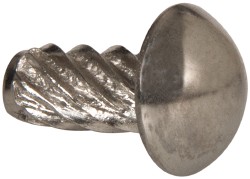If you examine your machine tools closely you may notice that the nameplates and information plates seem to be attached to the machine with what look like round-headed rivets. These are not rivets but rather a type of fastener called a "drive screw". They look somewhat like a rivet with very fast screw threads...
In use a hole is drilled into the nameplate and a matching hole is made in the machine to which the plate will be attached. The drive screw is threaded through the plate and driven (hence the name) into the hole to secure the plate.
If you want to restore or repaint the machine, a neat job may require removal of the plates. Ideally the drive screws should be removed carefully so the plate is not damaged but how to do that?
In very rare instances the hole is a through hole and, even more rarely, one can access the open end of the hole. In this case, a pin punch can be used to drive the screw out from the back side.
If the screw was not seated fully, it may be possible to get a thin screwdriver blade under it and, bit by bit, lever it up far enough to grab the head with lock jaw pliers and "unscrew" it from the hole. If you try this, put a pad under the screwdriver so it doesn't mar the plate. Often these plates are made of brass or aluminum, both soft metals, and can deform and dent easily.
If the screw is fully seated, the screwdriver pry may be a non-starter. In this case, use a thin saw blade or cutoff disk in a Dremel or Foredom tool to carefully put a slot in the head of the drive screw. Unscrew the screw far enough to grasp it firmly with lock jaw pliers and unscrew.
It should be obvious that these fasteners, once removed, are not reusable. Suppliers like MSC and McMaster-Carr carry them in a variety of sizes. Alternatively, you can thread the holes in the machine and use small machine screws to remount the plates.



 LinkBack URL
LinkBack URL About LinkBacks
About LinkBacks



 Reply With Quote
Reply With Quote

 Wonder if the NSA is listening. That might grab their attention.
Wonder if the NSA is listening. That might grab their attention. 

Bookmarks